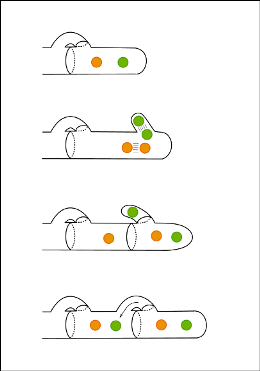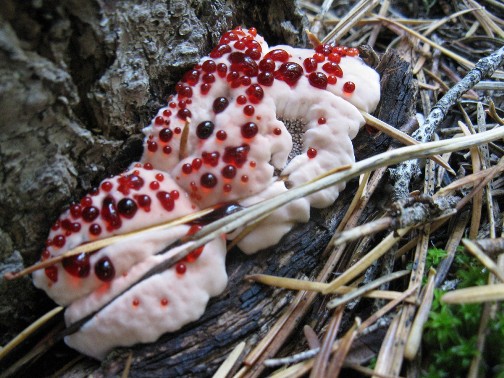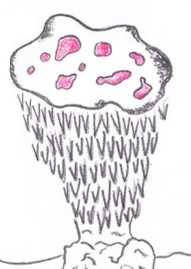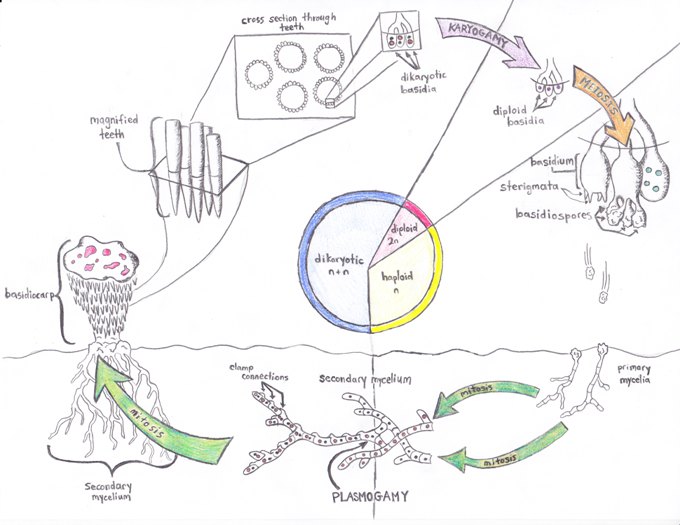
Life History and Reproduction
What came first, the spore or the mushroom? Let's
say the mushroom; thus, the lifecycle of H. peckii
would begin with a dikaryotic mushroom, or basidiocarp,
shown in the left center of the diagram below. The mushroom is
merely a spore's way a making oodles more spores. To do
so, each H.peckii
basidiocarp has a hymenophore full of tooth-like
projections each of which is lined with tiny club-shaped
structures called basidia. Spores are eventually borne on the
basidia. In the cross section through teeth in the diagram below,
the humps around the circumference of each tooth are basidia. Initially, the basidia are dikaryotic,
then they undergo karyogamy to form diploid basidia. After
that,
each diploid basidum goes through meiosis to produce four
haploid daughter nuclei. The daughter nuclei quickly
migrate to the edge of the basidum and pinch off into individual
basidiospores. (The small horn-like protrusions that form to
support the basidiospores are called sterigmata). In turn, the innumerable basidiospores produced
by
H peckii on its hymenophore germinate, are
dispersed in the wind, and ensconce themselves in the
fateful tract of ground
where they land. From there, the basidiospores grow
through mitosis into haploid primary mycelia. Eventually, two
haploid hyphae of complimentary mating types fuse through
plasmogamy to create a dikaryotic mycelium. To maintain a
dikaryotic state, the secondary mycelia of H. peckii
form clamp
connections (above). The resulting secondary mycelium grows into a matrix of mycelium which
eventually engenders a dikaryotic fruiting body when conditions are favorable(Campbell
et al., 2008). H.peckii spends approximately the same amount of
time in dikaryotic and haploid states, and has an exceedingly
transient diploid state.
H. peckii
would begin with a dikaryotic mushroom, or basidiocarp,
shown in the left center of the diagram below. The mushroom is
merely a spore's way a making oodles more spores. To do
so, each H.peckii
basidiocarp has a hymenophore full of tooth-like
projections each of which is lined with tiny club-shaped
structures called basidia. Spores are eventually borne on the
basidia. In the cross section through teeth in the diagram below,
the humps around the circumference of each tooth are basidia. Initially, the basidia are dikaryotic,
then they undergo karyogamy to form diploid basidia. After
that,
each diploid basidum goes through meiosis to produce four
haploid daughter nuclei. The daughter nuclei quickly
migrate to the edge of the basidum and pinch off into individual
basidiospores. (The small horn-like protrusions that form to
support the basidiospores are called sterigmata). In turn, the innumerable basidiospores produced
by
H peckii on its hymenophore germinate, are
dispersed in the wind, and ensconce themselves in the
fateful tract of ground
where they land. From there, the basidiospores grow
through mitosis into haploid primary mycelia. Eventually, two
haploid hyphae of complimentary mating types fuse through
plasmogamy to create a dikaryotic mycelium. To maintain a
dikaryotic state, the secondary mycelia of H. peckii
form clamp
connections (above). The resulting secondary mycelium grows into a matrix of mycelium which
eventually engenders a dikaryotic fruiting body when conditions are favorable(Campbell
et al., 2008). H.peckii spends approximately the same amount of
time in dikaryotic and haploid states, and has an exceedingly
transient diploid state.
H. peckii typically fruit in the late summer to autumn and
may do so irregularly— several years between fruiting episodes is
common. On top of that, it's not known exactly what "favorable
conditions" entail for H. peckii; thus, its intermittent fruiting
pattern remains somewhat of a mystery (Van der Linde, 2009).
H.peckii can also produce resting spores known as chlamydospores (right) that are warted like its regular spore, but have much thicker walls (Agerer, 1993). By forming these thick-walled chlamydospores, H. peckii is able to adapt when conditions are harsh and nutrients are less accessible.
When young, basidiocarps of H.peckii spectacularly display vibrant red exudates on their taut, cream to colored pileus. As the basidiocarps age however, they become less photogenic. Mature H. peckii basidiocarps appear dark brown and glabrous. Moreover, as mentioned in on the classification page, H peckii has indeterminate growth. That means H.peckii can engulf foreign organic matter in its growth path and amalgamate with other H. peckii fruiting bodies.

In other news, I hear that H. peckii's interactions with other organisms are simply fascinating.

